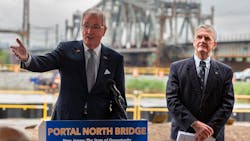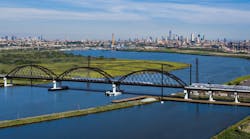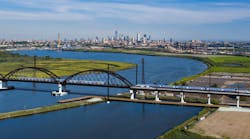Federal, state and transportation officials joined together to mark the start of construction of the Portal North Bridge. The start of construction on the project is the culmination of years of collaboration between project partners New Jersey Transit (NJ Transit), the Gateway Program Development Corporation, the Port Authority of New York and New Jersey, Amtrak and the federal government and advocacy efforts of the New Jersey Congressional delegation with support from elected officials in surrounding states.
“The esteemed elected officials, transportation executives and union members gathered here today to celebrate a national milestone are evidence of what we can achieve when we band together as Americans in pursuit of a common purpose,” said New Jersey Gov. Phil Murphy. “Safe, reliable and modern infrastructure is about more than just getting to work on time. It’s also about the thousands of good-paying jobs this project will create and the families they support. By improving connectivity, we will also promote economic opportunity, not just for New Jersey residents and commuters, but for the Northeast Corridor and our nation. The new Portal North Bridge symbolizes our lasting legacy and our commitment to the welfare and prosperity of all New Jerseyans.”
This legacy has been long-planned and hard fought for as the bridge – in recent memory – was the symbol of the aging infrastructure challenges faced by the U.S. The nearly 112-year-old bridge is the busiest rail bridge in the Western Hemisphere and a chokepoint on the Northeast Corridor (NEC) that has been responsible for thousands of hours of commuting delays. A malfunction of the bridge’s moveable swing span doesn’t only impact NJ Transit and Amtrak trains but has a cascading effect throughout the NEC.
“As all too many travelers are painfully aware, the existing bridge has been a source of countless delays and frustration for the millions of NJ Transit and Amtrak customers who ride along the bridge between New Jersey and New York annually, and its importance cannot be overstated,” said NJ Transit President and CEO Kevin S. Corbett. “Construction of a new bridge will not only create approximately 15,000 jobs and add billions of dollars to our local economy but, more importantly, it will provide safe, reliable rail service for all Northeast Corridor commuters between Washington, D.C., and Boston for generations to come.”
The project calls for constructing a new two-track fixed structure bridge over the Hackensack River using three 400-foot spans. In total, the project will see the construction of 2.44 miles of track infrastructure including 6,200 linear feet of new embankment sections and 6,700 linear feet of bridge and viaduct structure sections. In addition to removing the NEC bottleneck, the new Portal North Bridge will allow NJ Transit to increase capacity more than 14 percent with the addition of new multilevel railcars and more service. The new bridge will also span the river 50-feet higher than it currently does, which will allow Hackensack River marine traffic to pass without interrupting rail traffic.
“This project turns the Portal North Bridge from a chokepoint to an access point. It modernizes the way that people and goods get to and from this region that is responsible for 20 percent of America’s economic product every year,” said U.S. Secretary of Transportation Buttigieg. “I hope that this bridge will not only bring people to work and loved ones to where they need to be, but brings renewed confidence in our ability to get things done together. We are entering into a true infrastructure decade.”
The project is being funded by the U.S. Department of Transportation, NJ Transit and Amtrak. A Full Funding Grant Agreement was secured in January 2021 from the Federal Transit Administration’s Capital Investment Grants program for $766.5 million. Amtrak is contributing more than $97 million to the project and more than $57 million will come from FHWA Flexible Funds. More than $811 million is being covered with local funding.
“I am proud to join Secretary Buttigieg as construction begins on this critical project. It will bring an important part of our national infrastructure into the 21st century, creating jobs and getting Americans where they’re going quickly and safely,” said FTA Administrator Nuria Fernandez.
The project held a ceremonial groundbreaking in October 2021 attended by President Joe Biden ahead of the passage of the Infrastructure and Investment Act. In early April, the project was issued a Notice to Proceed, which set up contractor Skanska/Traylor Bros Joint Venture to begin construction on the project. The entire project is expected to take approximately 5.5 years to complete.
“Today’s event marks the beginning of this major construction on a project that will greatly benefit Amtrak and NJ Transit passengers by eliminating delays caused by an outdated, moveable bridge,” said Amtrak Board Chair Tony Coscia. “Having shovels in the ground means that the planning and talking are over; it’s time to build state-of-the-art infrastructure and make rail travel more reliable to the region’s train travelers.”

Mischa Wanek-Libman | Group Editorial Director
Mischa Wanek-Libman is director of communications with Transdev North America. She has more than 20 years of experience working in the transportation industry covering construction projects, engineering challenges, transit and rail operations and best practices.
Wanek-Libman has held top editorial positions at freight rail and public transportation business-to-business publications including as editor-in-chief and editorial director of Mass Transit from 2018-2024. She has been recognized for editorial excellence through her individual work, as well as for collaborative content.
She is an active member of the American Public Transportation Association's Marketing and Communications Committee and served 14 years as a Board Observer on the National Railroad Construction and Maintenance Association (NRC) Board of Directors.
She is a graduate of Drake University in Des Moines, Iowa, where she earned a Bachelor of Arts degree in Journalism and Mass Communication.





